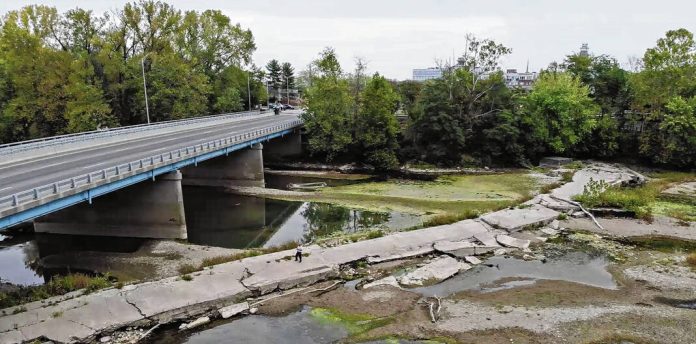
Photo provided An overhead view of the low-head dam in the East Fork White River which would be removed as part of the proposed Riverfront Project.
The firms managing a project to redevelop the city’s riverfront near the Second and Third Street bridges are seeking bids for construction work, including the removal of the low-head dam in the East Fork White River.
City officials said they could potentially break ground on the project as early as March.
Indianapolis-based firms Zurbuch Inc. and EDCO, who the city has hired to be the project’s constructor manager as constructor, has advertised that they are seeking bids for site clearing and enabling, in-river work, site concrete, site electrical, landscaping and fencing. The bids are due Feb. 8.
“You could see some work as early as the first of March with regard to removal of trees and things like that,” said city Redevelopment Director Heather Pope. “…There is a period that we have to avoid in-river work because of fish spawning. So, we will not be able to get in the river from, I believe, mid-March to the end of June sometime. You could see some in-river work as early as mid-March. If not, it will be the end of June before we’ll be able to get in the river.”
The estimated $14 million project seeks to address safety issues related to the deteriorating low-head dam in the East Fork White River without damaging wetlands located upstream or impacting the river water level through Mill Race Park.
In addition, the project is expected to safeguard the riverbanks from ongoing erosion, including on the west side of the river near the Third Street bridge, which was the site of a landfill from 1938 to 1966 that is believed to have accepted 3.46 million gallons of industrial wastes, including solvents, bases, paints and heavy metals, according to the U.S. Environmental Protection Agency.
City officials also have proposed building overlooks of the river, connections with the People Trail system and an in-water recreation area, branding the project as an effort to “create an iconic riverfront experience that improves safety.”
The funding for the project is expected to come from a variety of sources, including $2.43 million in confirmed funding from state grant programs, Duke Energy and the Columbus Park Foundation, officials said. That would leave about $11.58 million that the city would need for the project.
In 2022, the riverfront project received a $1.72 million Next Level Trail grant from the Indiana Department of Natural Resources and a $600,000 READI grant, a multi-million-dollar regional grant program in Indiana that is funded through the American Rescue Plan.
City officials said previously that they plan to use Central Tax Increment Financing (TIF) district funds to bankroll the project. A TIF district is a mechanism that allows the commission to siphon off increasing property taxes generated on commercial and industrial properties in a selected area to fund projects. TIF funds must be used for economic development or investment in infrastructure.
In December, the Columbus City Council approved a request to use TIF funding for the project.
However, the project’s final price tag could end up being somewhat lower, as officials have included a $3 million contingency into the estimated costs in case unanticipated costs arise during the project.
An economic analysis by James Lima Planning + Development presented during a joint city council and redevelopment meeting in November predicts that the project will contribute to greater economic output and net new tax revenue during construction and after the project is completed.
The estimated short-term benefits of the project, referring to benefits during the project’s construction, include the creation of 116 jobs and economic output of $19 million and $100,000 in local tax revenue and $280,000 in state tax revenue, according to the analysis.
Over the long run, the project is expected to attract visitors and yield annual economic dividends, including money spent on local goods and services such as food, retail, hospitality, entertainment and transportation, the analysis states.
The long-term economic benefits of the project are estimated to include nine to 32 jobs per year, an economic output of $589,000 to $2 million per year, annual local tax revenue of $16,000 to $56,000 and annual state tax revenue of $31,000 to $108,000, according to the analysis, which officials aid was based on “conservative baseline assumptions.”
Until recently, officials had been navigating a maze of regulatory hurdles in which four environmental regulators — the Indiana Department of Natural Resources, Indiana Department of Environmental Management, U.S. Army Corps of Engineers and U.S. Environmental Protection Agency — needed to sign off the project before bids can go out and construction can start.
One of the final hurdles included getting approval from the U.S. Army Corps of Engineers, which had requested input from the EPA, city officials said previously. The Louisville Division of the U.S. Army Corps of Engineers told The Republic that it had approved a permit that would allow the city to proceed with the project on Sept. 21.




